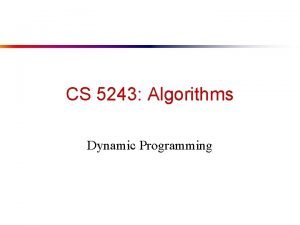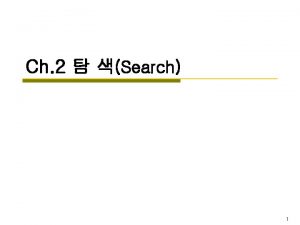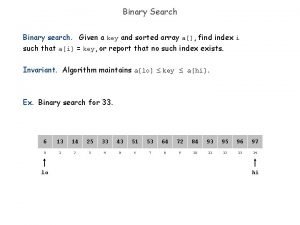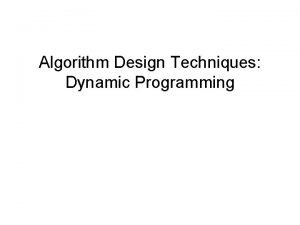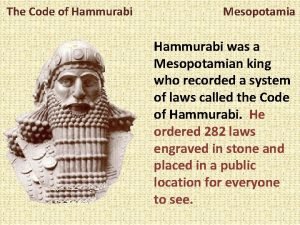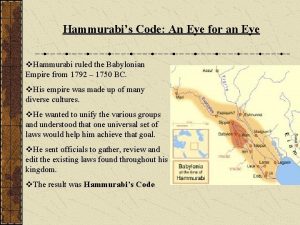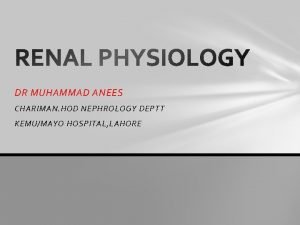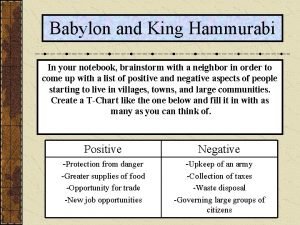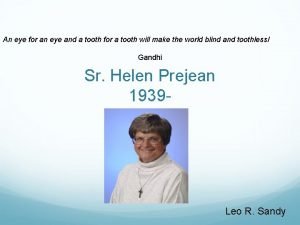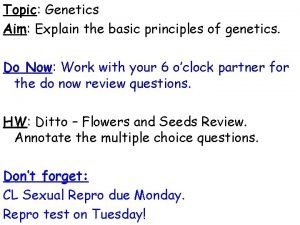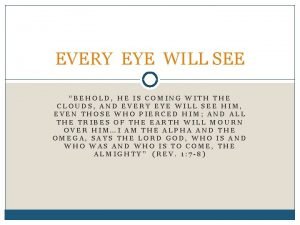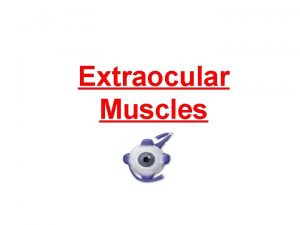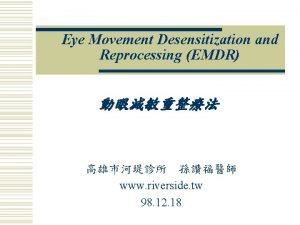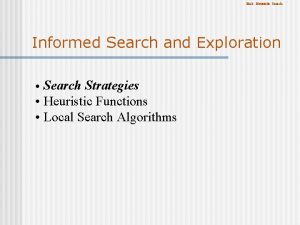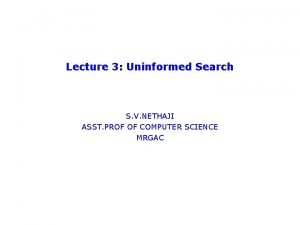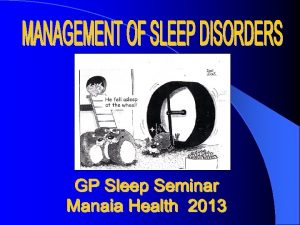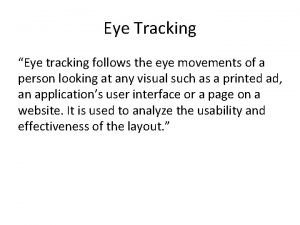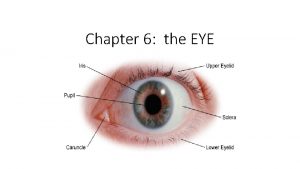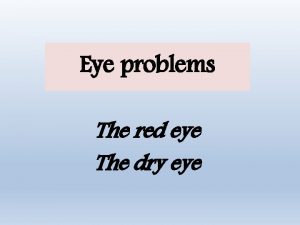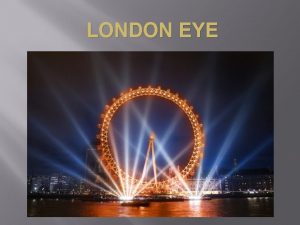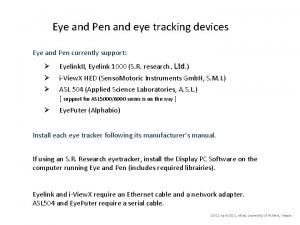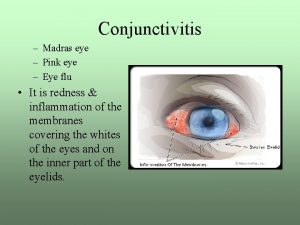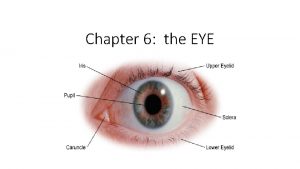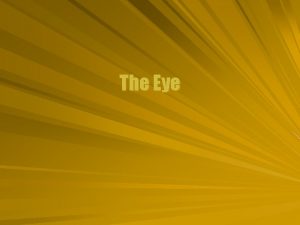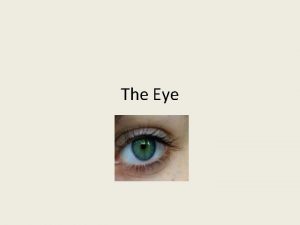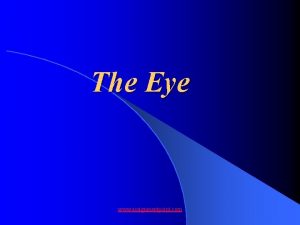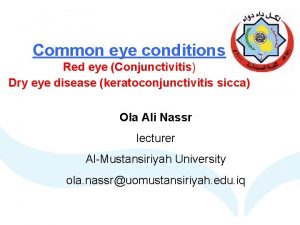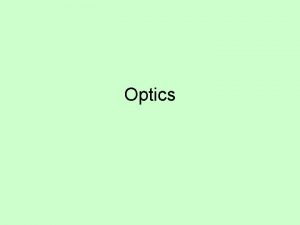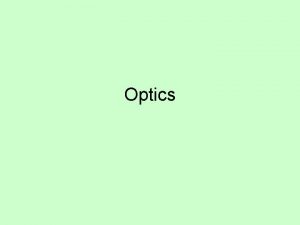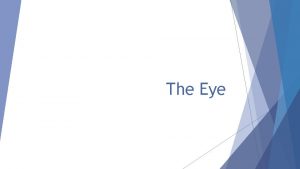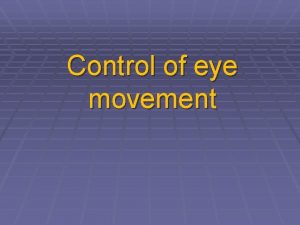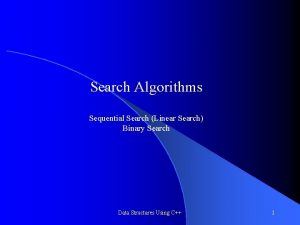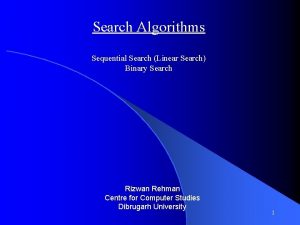Optimal Eye Movement Strategies In Visual Search Visual































- Slides: 31

Optimal Eye Movement Strategies In Visual Search

Visual Accuity ü http: //www. svi. cps. utexas. edu/Hamilton. Creek. mov

Images from Laura Walker Renninger



http: //www. svi. cps. utexas. edu/foveator. htm

Attention (And Fixation) Shifting Strategies ü Visual Saliency § Attend to what stands out from background ü Experience Guided Search (last class) § Attend to locations of maximum posterior probability (MAP) ü Information Maximization § Given low resolution in parafovea, perhaps we move our eyes to gather as much information as possible. § Low resolution in parafovea -> uncertainty § Move eyes to reduce this uncertainty (= gather information) ü Information maximization and MAP both predict task specificity of eye movements.

Yarbus (1967)

Najemnik & Geisler (2005) ü 1/f noise same statistics as natural images ü Target sine wave grating ü Manipulations Target contrast Background noise contrast

Measuring Visibility At Fovea ü ü ü Subject fixates at center Two displays in quick succession Task: determine which one contains the target grating Measure accuracy as a function of target and background contrast at each location For center location: Threshold = 82% accuracy

Derive Discriminability Curves ü ü For a given background contrast and target contrast d’: signal to noise ratio If noise is Gaussian, 1/d’ 2 is variance of noise distribution Two noise components § external noise: due to 1/f background contrast. 05, target contrast. 07 background contrast. 20 and target contrast. 19 § internal noise: due to inefficiency of sensory system

Terminology d’E(i): discriminability due to external noise at location i d’I(i, k(t)): discriminability at location i due to internal noise given fixation at current time is k(t) Combined noise from two independent Gaussian sources:

Snapshot Likelihood (Observation) Model ü ü Imagine a feature detector at each location that matches the target template (grating) against the visual information at that location Wi, k(t): Observation at location i at time t when fixation at k(t) § Mean = 0. 5 if target present, -0. 5 if target absent § Drawn from Gaussian with variance g[i, k(t)]-1

Integrating Sequence Of Observations ü ü Sequence of t=1…T fixations At each fixation, obtain noisy evidence concerning target presence at each location i § Wk(1), Wk(2), … Wk(T) ü Bayesian ideal observer:

Quiz ü ü Are the W’s independent conditioned on a location (i or j)? It depends on nature of internal and external noise.

Conditioning On External Noise ü ü xi: (unknown) external noise at location I Marginalize out over x: Assuming internal noise is independent over time and space of external noise: And external noise is independent over space:

Conjugate Priors To The Rescue ü Because internal noise and external noise are Gaussian, = +1 if q=i, -1 otherwise ü Integral can be computed analytically. Gaussian prior Gaussian likelihood -> Gaussian posterior

Conjugate Priors To The Rescue ü ü ü Form of likelihood: Form of posterior: But ugly constant is the same in numerator and

Final Result With Related to 1/variance Of observation ü Intuitive result Weighted sum of evidence, where weight ~ reliability Simple incremental rule for computing over time

What We Haven’t Discussed Yet ü How is next fixation location chosen? § Go to location most likely to contain target (MAP location) § Go to location that will obtain the greatest expected reduction in uncertainty (entropy) § Go to location that will obtain information that will maximize probability of correctly identifying target ü Comparison to random searcher § Ideal decision maker, but chooses fixations randomly

Choosing Next Fixation: Some Ugly Details C: correct identification of target Normal density Normal cdf Depends on mean and variance of probability density for an observation

Generating Fixation Sequences

Average Spatial Distribution Of Fixations For 1 st, 3 d, and 5 th Saccades Ideal and Human Observers

Results I ü Median # fixations to locate target, as a function of foveated target’s visibility Background noise contrast =. 025 solid = ideal searcher Background noise contrast =. 20 dashed = random searcher Observer 1 Observer 2

Results II ü Median number of fixations to locate target as a function of target eccentricity (x axis) and target visibility in fovea (d’) Background noise contrast =. 05 Background noise contrast =. 20 Solid = ideal observer Dots = medians (less reliable at small eccentricities)

Results III ü Posterior probability at target location as a function of the number of fixations prior to finding target dashed = random searcher solid = ideal observer

Are Fixations Information Seeking? ü ü Comparison to MAP selection Can’t distinguish

Distribution of Fixations ü MAP selection vs. information seeking

Distribution of Fixations II ü ü Direction of fixations relative to center of display Confirms previous result

Take Home ü Visual search can be cast as optimal § Optimal choice of next fixation § Possibly not optimal integration of information over fixations ü …subject to limitation on quality of visual information § Noise in images § Acuity limitation of retina

Take Home II ü ü We’ve discussed several Bayesian accounts that cast vision and attention in terms of ideal observers. How does this analysis give us insight into how the visual system works? § Rigorous starting point for developing models § Provides well motivated computational framework § Can ask how human behavior deviates from optimal computation § Can ask how people achieve near-optimal performance with imperfect, noisy neural hardware
 Optimal binary search tree java
Optimal binary search tree java Cost minimization formula
Cost minimization formula Optimal binary search tree java
Optimal binary search tree java Optimal binary search tree
Optimal binary search tree Optimal binary search tree
Optimal binary search tree An eye for an eye hammurabi
An eye for an eye hammurabi Birds eye angle
Birds eye angle Hammurabi code eye for an eye
Hammurabi code eye for an eye Anemia eyes vs normal
Anemia eyes vs normal Hammurabi code an eye for an eye
Hammurabi code an eye for an eye An eye for an eye a tooth for a tooth sister act
An eye for an eye a tooth for a tooth sister act Are blue eyes dominant or recessive
Are blue eyes dominant or recessive An eye for an eye meaning
An eye for an eye meaning Behold he is coming
Behold he is coming Nerve supply of superior oblique
Nerve supply of superior oblique 動眼減敏重整療法
動眼減敏重整療法 Non-movement area
Non-movement area Axial movement dance definition
Axial movement dance definition Google image reverse search
Google image reverse search Uninformed search
Uninformed search Informed (heuristic) search strategies
Informed (heuristic) search strategies Successful job search strategies
Successful job search strategies Comparison of uninformed search strategies
Comparison of uninformed search strategies Mobirati
Mobirati Colorter
Colorter Federated discovery
Federated discovery èinterest
èinterest Federated search vs distributed search
Federated search vs distributed search Informed and uninformed search
Informed and uninformed search Https://tw.images.search.yahoo.com/images/view
Https://tw.images.search.yahoo.com/images/view Best first search is a type of informed search which uses
Best first search is a type of informed search which uses Blind search dan heuristic search
Blind search dan heuristic search

